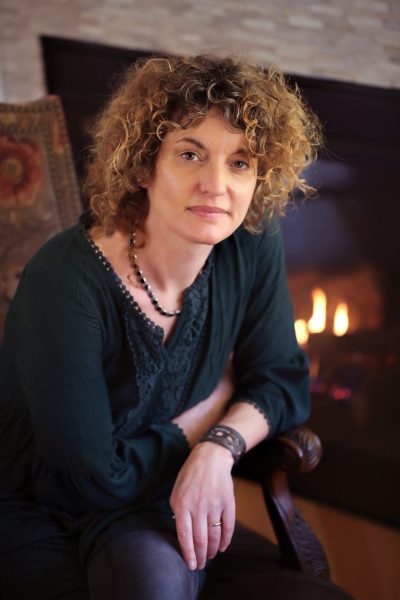What I love about “How to Build a Bunker” is how the mother’s abandonment is the “bomb” that serves as the inciting incident, how her absence looms over the story. The world may not really be ending, but to this family, it may as well be. Why did you choose to not give readers access to any dialogue from the mother when she calls?
At first, I played around with giving the mother a bigger part in the story. In one draft, Rob and the narrator visit their mother in a different house and see photos of other children hanging on her walls. But I quickly realized the story was about what she’d left behind and not her. To give her a voice would have taken from the sense of loss and the sense of narrator’s world ending as she knew it. Also, the family are all dealing with her abandonment differently and the narrator doesn’t want to think of her mother. She clings to her father and is more aware of where he is and what he is doing during the conversations than what her mother is saying. Because she is so young, she wouldn’t be able to question anything her mother said, or voice her distrust, which was how I imagine she feels even as a child. So, I felt the silence and sense of detachment worked better.
What inspired you to write the story in second-person “how-to” form?
I like the way the second-person “how-to” form invites the reader into the family life, but I didn’t think to write the story this way from the beginning. The first drafts, I started the story with the father calling the children for drills to the bunker six months after the mother left. After a few starts, I understood I had to go back to “how to build,” in order to examine how each member of the family is dealing with the abandonment through the different stages.
I admire the narrator’s empathy and selflessness in the situation; they support their father throughout the bunker endeavor without complaint because they realize this is bigger than the bunker. How might the story be different if written from the father’s point of view?
I think the reader would have wanted more from him. They would have wanted to know why his wife left, and there might be the question of who’s to blame. But as it is, we accept what the narrator is saying without judgment. She is more of a witness to her father’s need to protect his children, and to her brother’s anger. In this capacity, we only get hints about her when her father lets her climb into the bunker before it’s finished and she remembers the bird in the nest, and when she imagines her mother is a voice trapped down the line. With the father narrating that distance would have been very difficult to do.
Before reading your story, I didn’t know a bunker must be at least three feet deep to effectively protect its occupants from a nuclear blast. I’ll have to remember that—you know, just in case. What was your research process like when writing this story? Did you discover anything else that didn’t make it in the final draft?
I had no idea how to build a bunker before I started this story. I read what I could but the YouTube videos were the greatest help. There were a few I watched numerous times to understand the steps. There was a lot of information that didn’t make it in. The dad would have needed to rent excavation equipment or hire someone to dig a hole that size, and he would have needed to put in air filters and buy an air filtration system, and the bunker would have needed to be tilted to stop from flooding.
How do you think the world will end? Or, how do you hope it will?
Abruptly, that’s what my husband said when I asked this question. That’s him at his most optimistic. I don’t think about it much now, which might have been different a few months ago, but I’d have to agree with his answer, and hope that we won’t need any bunkers.



 The core workshop of SmokeLong Fitness is all in writing, so you can take part from anywhere at anytime. We are excited about creating a supportive, consistent and structured environment for flash writers to work on their craft in a community. We are thrilled and proud to say that our workshop participants have won, placed, or been listed in every major flash competition. Community works.
The core workshop of SmokeLong Fitness is all in writing, so you can take part from anywhere at anytime. We are excited about creating a supportive, consistent and structured environment for flash writers to work on their craft in a community. We are thrilled and proud to say that our workshop participants have won, placed, or been listed in every major flash competition. Community works.